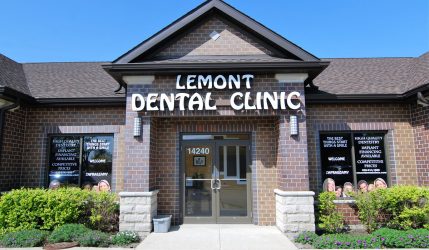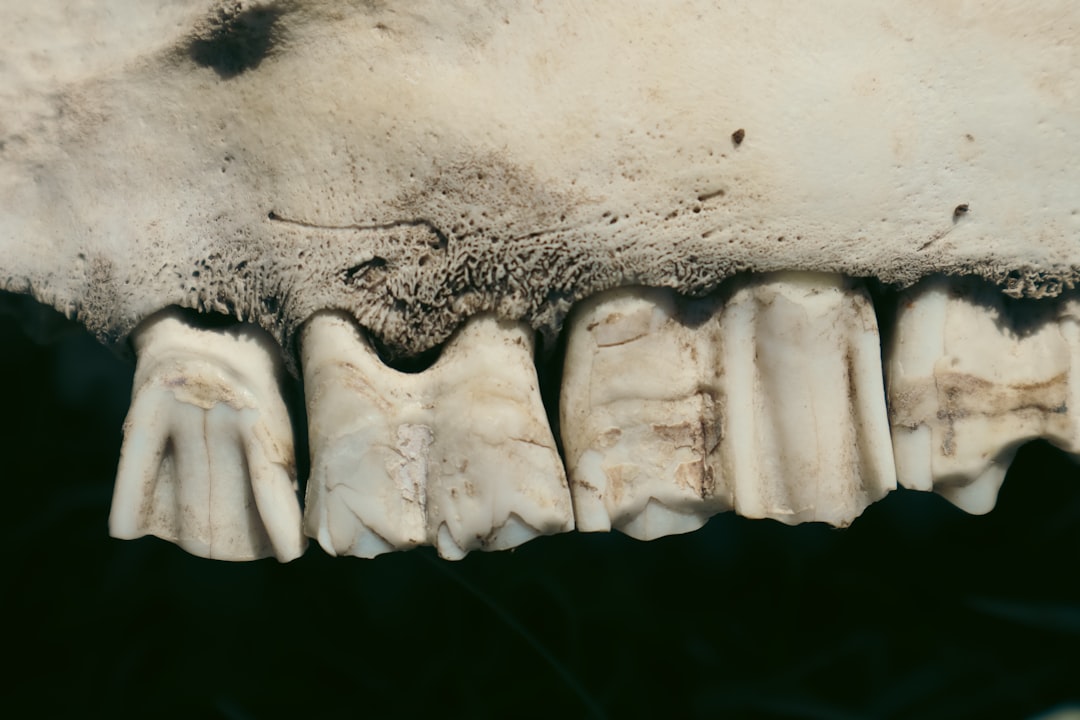Understanding Your Options for Replacing Missing Teeth
Different types of partial dentures offer effective solutions for replacing missing teeth, restoring both function and confidence to your smile. Whether you’re missing one tooth or several, the right partial can make a significant difference.
The main types of partial dentures include:
- Cast Metal Partial Dentures – Durable metal framework ($1,000-$2,500)
- Flexible Partial Dentures – Metal-free, comfortable material ($800-$1,500)
- Acrylic Partial Dentures (“Flippers”) – Affordable, temporary solution ($695-$1,200)
- Implant-Supported Partials – Most stable option using dental implants
- Fixed Bridges – Non-removable solution attached to adjacent teeth
Beyond aesthetics, missing teeth can make eating and speaking difficult and cause remaining teeth to shift. Partial dentures help restore proper chewing function, improve speech, and maintain your facial structure by filling these gaps.
The right choice depends on your budget, the number of teeth being replaced, and your preferences for comfort and appearance. Some prefer the stability of metal, while others choose flexible options for aesthetics.
At Lemont Dental Clinic & Gentle Touch Dentistry, we help patients steer the different types of partial dentures to find the best solution for their unique needs, restoring both function and confidence.
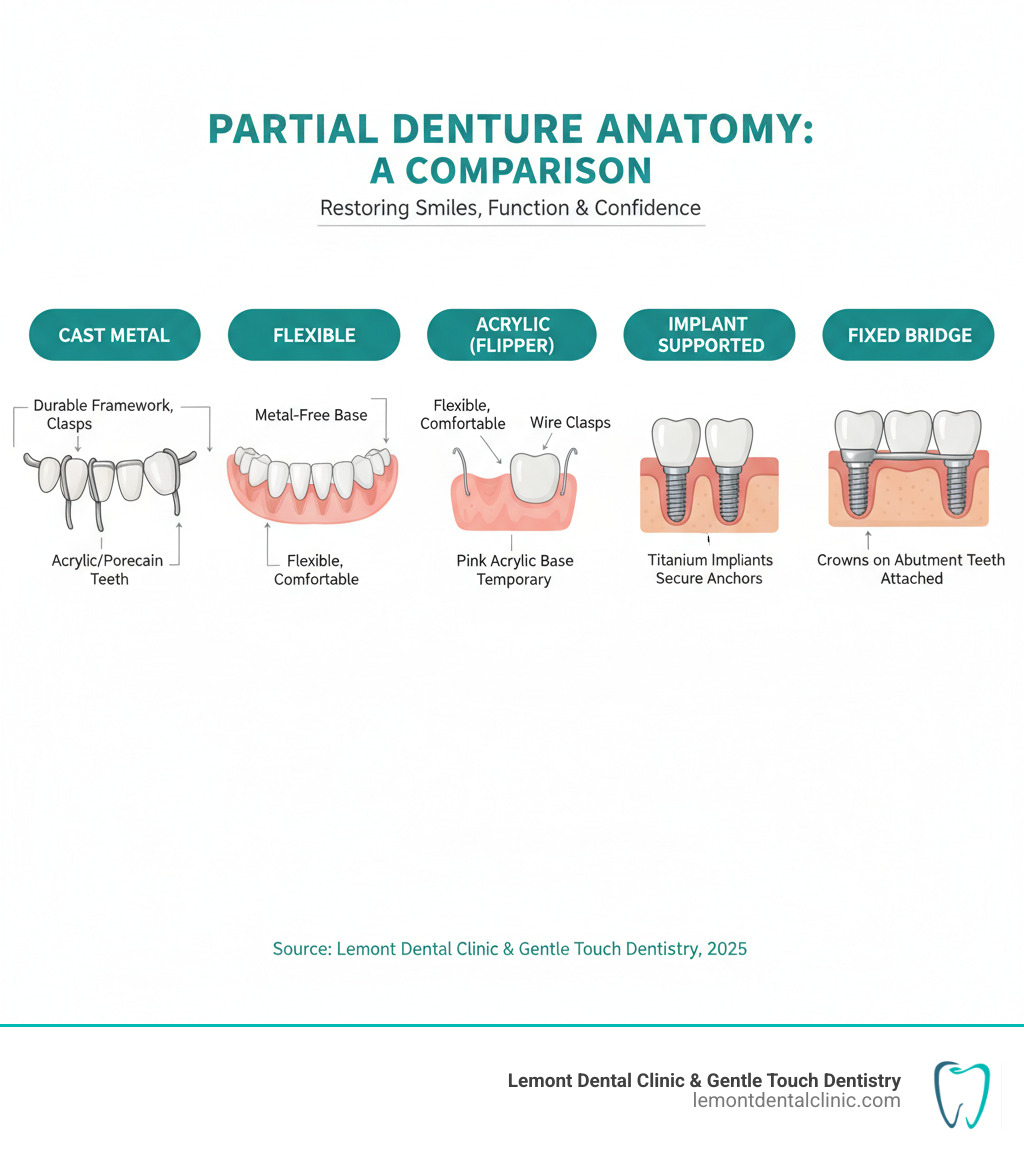
Understanding Partial Dentures: More Than Just Filling Gaps
When you have missing teeth, different types of partial dentures do more than just fill gaps; they play a vital role in your oral health and comfort. They are designed for people who have lost some teeth but still have healthy natural ones remaining.
Why Partial Dentures Are Used
-
Improved chewing ability: Missing teeth can make eating a challenge, affecting your nutrition. Partial dentures restore this function, letting you enjoy a wider variety of foods.
-
Improved speech: Your teeth help form sounds correctly. Gaps can cause a lisp or make certain words difficult to pronounce. A partial denture can restore clear, confident speech.
-
Preventing teeth from shifting: When a tooth is lost, neighboring teeth can drift into the empty space, and the opposing tooth can move as well. This can disrupt your bite and lead to further dental problems. Partial dentures prevent this shifting.
-
Supporting facial structure: Teeth support your cheeks and lips. Without them, your face can take on a sunken appearance. Partials help maintain your natural facial contours.
Who Is a Good Candidate
You are likely a good candidate for partial dentures if you have one or more missing teeth but still have healthy natural teeth to support an appliance. They are an excellent choice for those who want to restore their smile with a removable, less invasive option.
As Dr. Avinash Bidra from the UConn School of Dental Medicine explains, losing even a single tooth starts a chain reaction: “When you lose even a single tooth, it will result in bone loss, change the bite, cause food impaction, and result in adjacent teeth moving towards the missing space.” This highlights the importance of addressing missing teeth promptly.
Modern different types of partial dentures offer solutions for nearly every situation and budget, from temporary options to long-term restorations.
For a complete overview of all your tooth replacement options, check out our guide on different types of fake teeth. Understanding all your choices helps you make the best decision for your unique situation.
Exploring the Different Types of Partial Dentures
When choosing a partial denture, you have several excellent options. Understanding the most popular different types of partial dentures will help you make an informed decision for your unique situation.
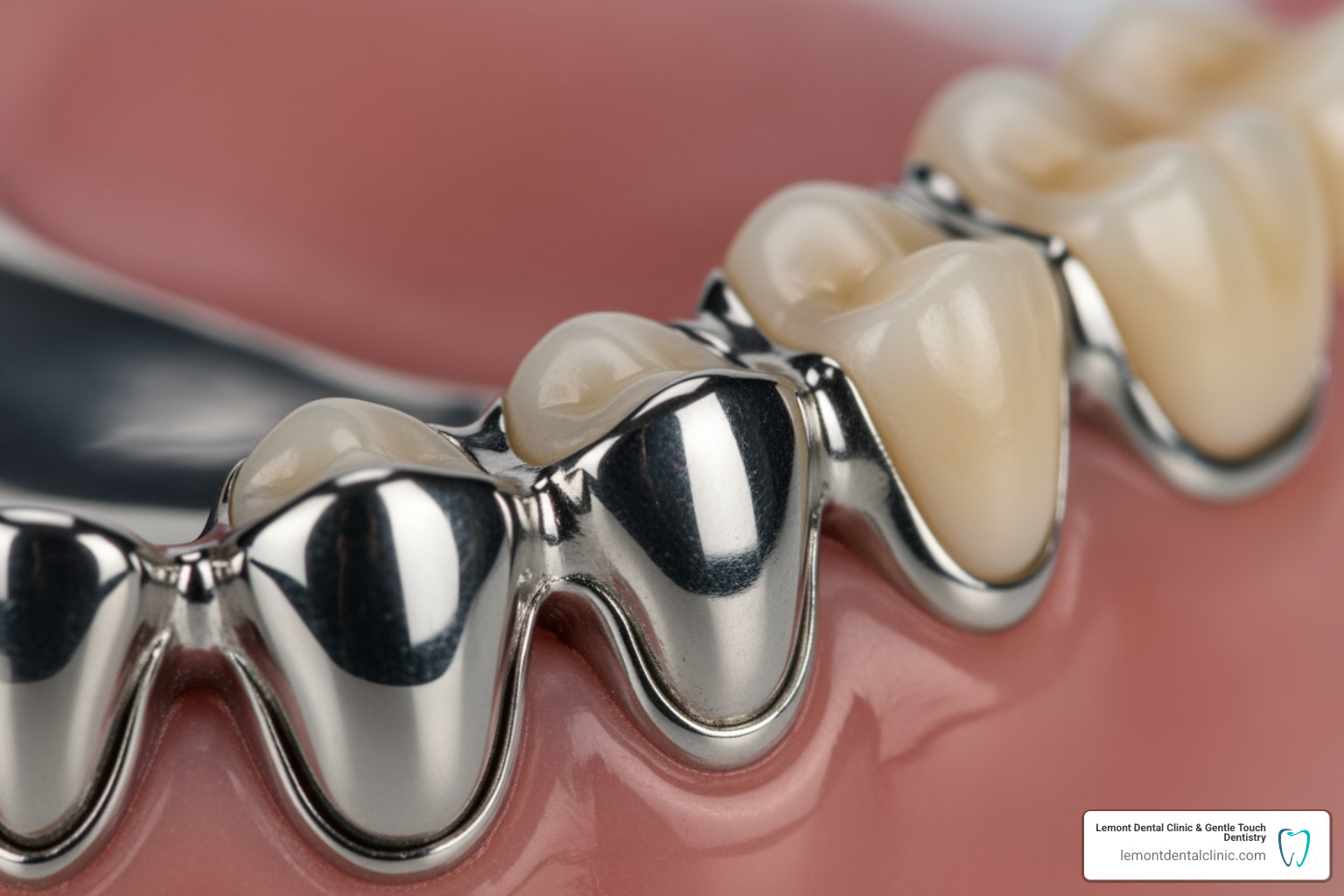
Cast metal partials are the gold standard for durability. Their strong yet thin framework is made from a cobalt-chromium alloy, with a lighter, hypoallergenic titanium option also available. The framework includes custom clasps that grip natural teeth for a secure fit.
- Pros: Highly durable and strong, thin and less bulky, provides excellent stability.
- Cons: Metal clasps can sometimes be visible, and they are more expensive than other options.
- Cost & Lifespan: They typically cost $1,000 to $2,500 and can last for up to 15 years with proper care.
Flexible Partial Dentures
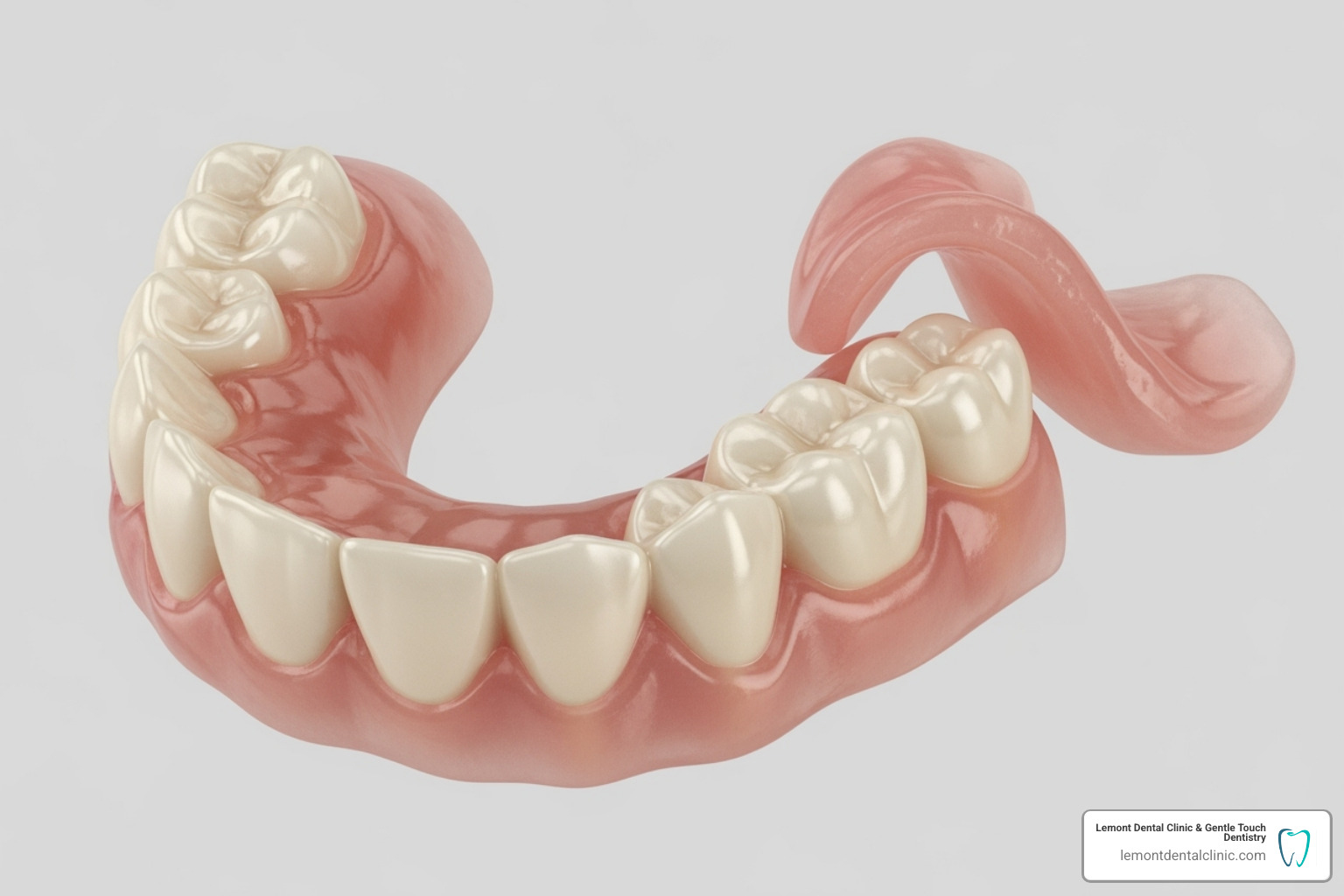
Made from a thermoplastic nylon resin, flexible partials are a metal-free alternative designed to blend seamlessly with your gums. Instead of metal clasps, they use their flexibility to grip teeth and gum tissue.
- Pros: Excellent aesthetics with no visible metal, very comfortable and lightweight, ideal for those with metal sensitivities.
- Cons: Difficult to repair or adjust, and their flexibility can feel less stable during chewing compared to rigid partials.
- Cost & Lifespan: The cost ranges from $800 to $1,500, and they can last up to 15 years with attentive care.
For more general information about dentures, the Cleveland Clinic’s guide provides valuable insights.
Acrylic Partial Dentures (“Flippers”)
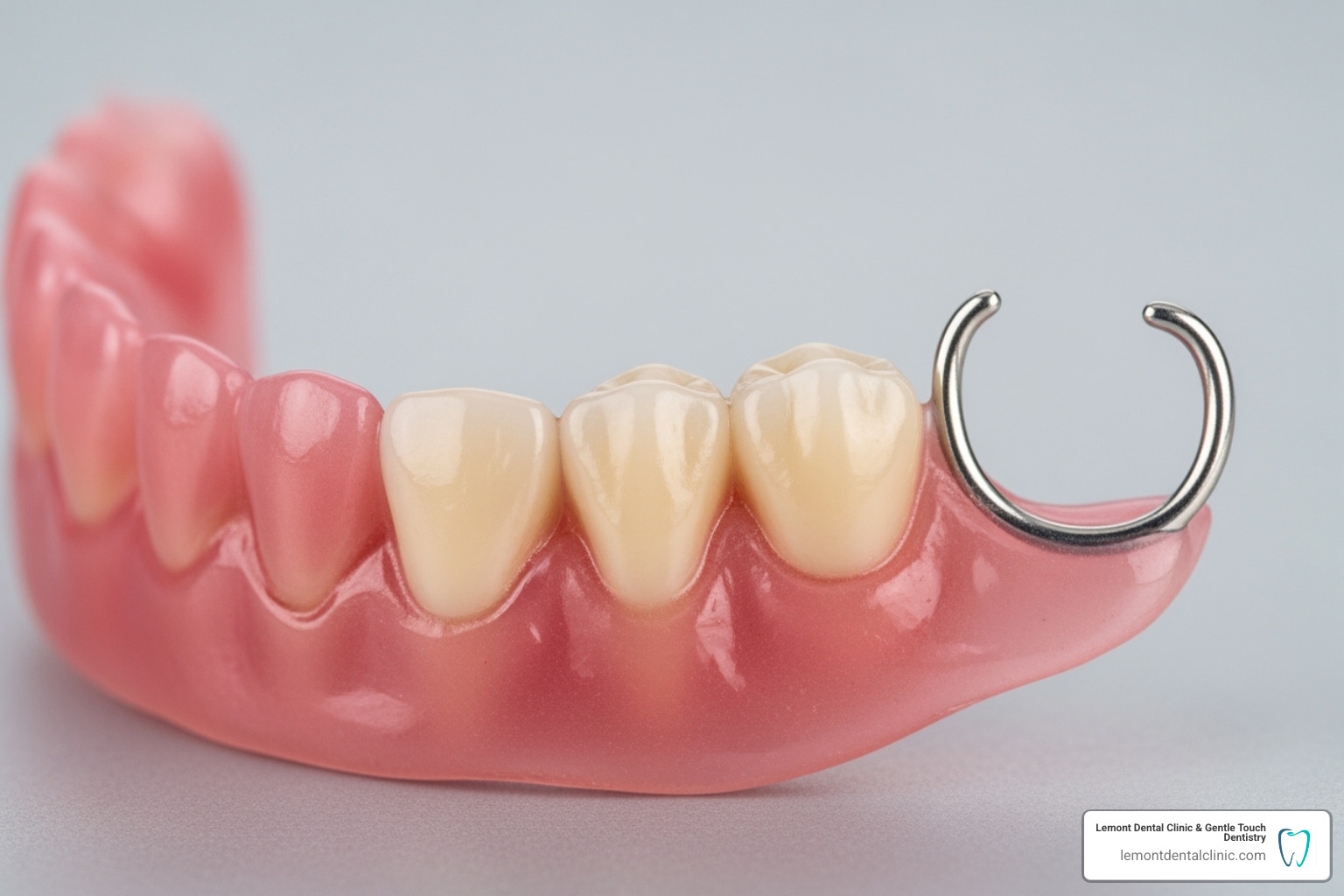
Acrylic partials, or “flippers,” are often used as an introductory or temporary solution. They consist of a pink acrylic base with prosthetic teeth and simple wire clasps for retention.
- Pros: Most affordable option, quick to fabricate, and easily adjusted or modified.
- Cons: Bulkier and less durable than other types, and the wire clasps can be visible.
- Cost & Lifespan: They cost between $695 and $1,200 and typically last five to eight years.
To see how acrylic partials compare to other options, our guide on types of dentures and cost provides more detail.
Advanced and Fixed Solutions for Missing Teeth
For those seeking more permanence and stability than removable partials, advanced and fixed solutions are available. These options represent the top tier of tooth replacement, offering a more natural feel, though they require a larger initial investment.
A Closer Look at Different Types of Partial Dentures: Implant-Supported
Implant-supported partials are the most stable option among the different types of partial dentures. They anchor directly to dental implants—small titanium posts surgically placed in the jawbone—instead of clasping onto natural teeth.
After the implants fuse with the bone over a few months, the partial denture is attached, providing a level of stability unachievable with traditional partials. This eliminates wobbling or slipping.
- Advantages: Superior stability for confident chewing, preservation of jawbone, and no stress on remaining natural teeth.
- Considerations: The process requires surgery and a longer timeline (several months) for healing and integration. The cost is also higher due to the surgical procedure and advanced materials.
Dental implants themselves are designed to last a lifetime, making this an excellent long-term investment. For more details, see our guide on implant dentures.
Fixed Bridges
A fixed dental bridge is a non-removable appliance that permanently fills the gap left by missing teeth. It consists of crowns placed on the healthy teeth on either side of the gap (abutment teeth), which support the artificial teeth (pontics) in between.
- How they work: The adjacent teeth are prepared for crowns, and the entire bridge unit is crafted as one piece and cemented into place.
- Advantages: Feels natural and functions like your original teeth, with no need for removal for cleaning or sleeping.
- Considerations: Requires altering healthy adjacent teeth to place crowns. Cleaning under the pontic requires special tools like floss threaders.
A fixed bridge restores your ability to chew, maintains facial shape, and prevents remaining teeth from shifting, making it a popular choice for a permanent solution.
Making the Right Choice: A Comparison of Partial Denture Types
Choosing the right partial denture is a personal decision based on your health, aesthetics, lifestyle, and budget. At Lemont Dental Clinic & Gentle Touch Dentistry, we guide you to an informed choice that brings comfort and confidence.
Comparing the Different Types of Partial Dentures
This side-by-side comparison of removable options highlights the trade-offs between the different types of partial dentures.
| Feature |
Cast Metal Partial Dentures |
Flexible Partial Dentures |
Acrylic Partial Dentures (“Flippers”) |
| Durability |
High (very strong, resistant to breakage) |
Medium (durable, but can flex and may not be repairable) |
Low (most prone to breakage, often temporary) |
| Aesthetics |
Medium (metal clasps can be visible) |
High (no visible metal, blends with gum tissue) |
Medium (can be bulky, wire clasps often visible) |
| Comfort |
High (thin framework, precise fit) |
High (lightweight, flexible, gentle on gums) |
Low (bulkier base, can feel less stable) |
| Average Cost |
$1,000 – $2,500 |
$800 – $1,500 |
$695 – $1,200 |
There is no single “best” option, only the best fit for you. A flexible partial may be ideal for aesthetics, while a cast metal partial offers maximum strength.
The Fitting Process: From Impression to Final Fit
Getting fitted for any of the different types of partial dentures is a meticulous process to ensure a precise fit.
- Initial Consultation: We assess your oral health, discuss your needs and budget, and recommend the best partial denture type for you.
- Impressions and Measurements: We create detailed molds of your jaws and measure your bite to serve as the blueprint for your new partial.
- Wax Try-In: You’ll test a wax replica of your partial, allowing us to make adjustments to the tooth placement, shade, and shape until you are satisfied.
- Final Fitting: We place your completed partial, check the fit, and make minor adjustments for comfort. We also provide detailed care instructions.
Over time, a denture may need a reline to maintain its fit. Learn more about what happens during a denture reline.
Caring for Your Partial Dentures
Proper care is essential for the longevity of your partial denture and your oral health.
- Daily Cleaning: Remove and rinse your partial after meals. Brush it daily with a soft-bristle denture brush and non-abrasive cleanser. Avoid regular toothpaste.
- Soaking: Soak your partial overnight in a denture cleaning solution to kill bacteria and keep it hydrated.
- Handling: Handle your partial over a soft towel or basin of water to prevent breakage if dropped. Store it in water or a soaking solution when not in use.
- Regular Check-ups: Continue with regular dental visits to check the fit of your partial and the health of your remaining teeth and gums.
The American Dental Association provides excellent denture care and maintenance guidelines.
Frequently Asked Questions about Partial Dentures
At Lemont Dental Clinic & Gentle Touch Dentistry, we often answer questions about the different types of partial dentures. Here are some of the most common concerns.
How long do partial dentures last?
The lifespan of a partial denture depends on the type, your care routine, and natural changes in your mouth.
- Acrylic Partials: Typically last 5 to 8 years.
- Cast Metal Partials: Can last up to 15 years due to their strong metal framework.
- Flexible Partials: Can also last up to 15 years with proper care.
Regular check-ups and professional relines are crucial for extending the life of any partial denture by ensuring it continues to fit well.
Can I sleep with my partial dentures in?
We generally recommend removing your partial dentures at night. This gives your gum tissues time to rest and recover from the pressure of wearing the appliance. Removing them also prevents bacterial buildup under the denture and allows for better overall oral hygiene, helping to protect your remaining teeth and gums from disease.
Give your mouth a break for at least six to eight hours daily, and always store your partial in water or a soaking solution to keep it from drying out.
Will partial dentures affect my speech or eating?
There is an initial adjustment period with any of the different types of partial dentures.
-
Speech: You might notice a slight lisp or difficulty with certain words at first. This is normal and typically resolves within a few days to weeks with practice. Reading aloud can help you adapt more quickly.
-
Eating: Your bite will feel different. Start with soft foods cut into small pieces. As you gain confidence, gradually introduce firmer foods. Chewing on both sides of your mouth can help stabilize the partial. Avoid very hard or sticky foods initially.
With a little patience, you’ll soon be speaking and eating with complete confidence.
Start Your Journey to a Complete Smile
Choosing the right partial denture is a significant step toward restoring your smile and confidence. As we’ve explored the different types of partial dentures, it’s clear the best choice depends on your unique health needs, budget, and aesthetic goals.
Consulting with an experienced dental professional is crucial for a successful outcome. At Lemont Dental Clinic & Gentle Touch Dentistry, we guide you through the options. Our doctors use the latest technology to provide comprehensive evaluations, listen to your concerns, and recommend the ideal solution for you.
We proudly serve communities throughout Illinois, including Lemont, Palos Hills, Chicago Ridge, Worth, Palos Park, Hickory Hills, Oak Lawn, Orland Park, Palos Heights, Bolingbrook, Romeoville, Palisades, and Lockport Heights. Our focus is on delivering high-quality, comprehensive dental care that combines quality with competitive pricing.
Your journey to a complete smile begins with a conversation. The right partial denture can restore not just your teeth, but your quality of life.
Don’t let missing teeth impact your daily life. Reach out to us today to find the perfect solution that brings back your confidence and comfort.
Find dentures near you and schedule a consultation
